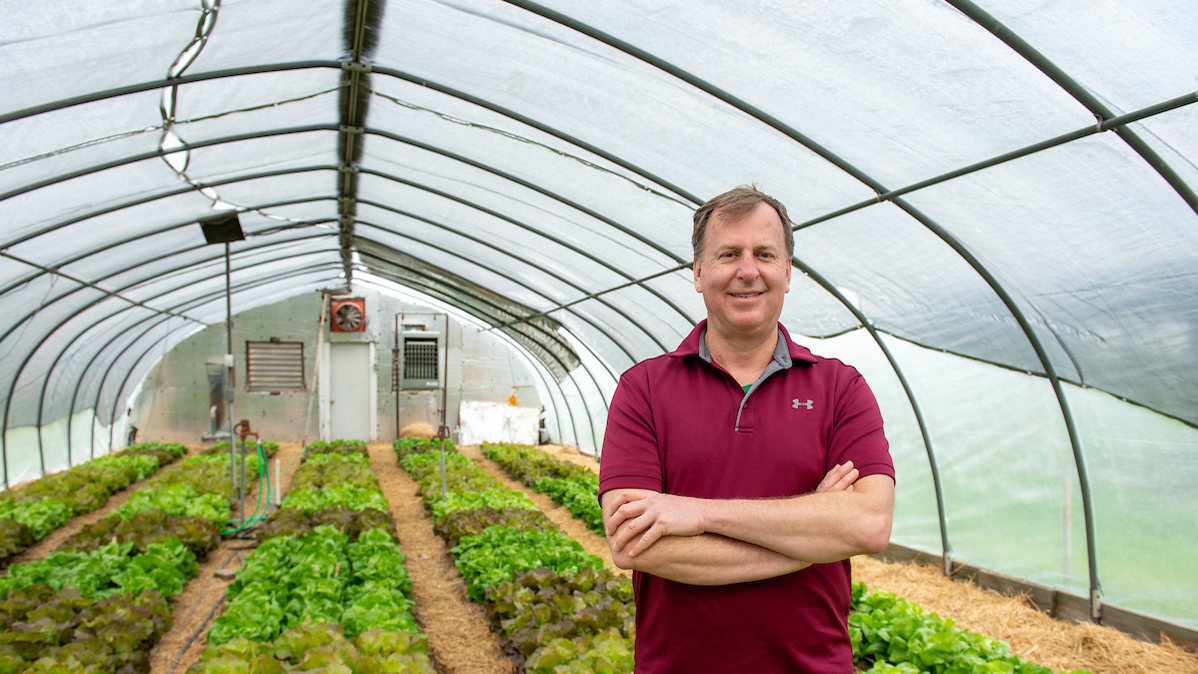
Alan Walters, professor of vegetable science at Southern Illinois University Carbondale, stands in one of the high tunnels he uses to grow butterhead lettuce. Walters recently set out to investigate the potential for farmers to bring butterhead lettuce to local tables, using such growing facilities to get a jump on springtime planting. (Photo by Yenitza Melgoza)
June 15, 2021
SIU vegetable scientist explores how farmers can get more out of their hoop houses
CARBONDALE, Ill. — The lettuce grown in the high tunnels at Southern Illinois University Carbondale isn’t the only leafy green stuff a researcher is interested in creating. He also wants to see local farmers explore such methods to put some cash in their pockets while making an impact on local fresh produce availability.
Although growing in popularity among commercial growers and hobby gardeners, the unheated high tunnels – or hoop houses, as they sometimes are called – are underutilized and hold much potential, said Alan Walters, professor of vegetable science at SIU. Walters recently set out to demonstrate the potential for farmers to bring butterhead lettuce to local tables, using an experimental high tunnel at the university.
“There is ample opportunity for expanding high tunnel production, without saturating local markets,” Walters said. “Most growers in Southern Illinois use high tunnels for tomatoes, but some have learned the value of diversifying their high tunnel to maximize profits.”
The U.S. Department of Agriculture Specialty Crop Grant, administered by the Illinois Department of Agriculture, funded Walters’ research.
Many benefits to growing, buying local
Growing, selling and buying local foods holds many benefits for both farmers and consumers. Local foods typically have more flavor, as growers usually harvest them at their peak instead of earlier for shipping purposes and longer shelf life. Some local fruits and vegetables end up in local stores as little as 24 hours after harvest. This quick turnaround also means local foods also have more nutrients.
A local foods model supports the local economy, benefits the environment and promotes a safer food supply, Walters said. And local farmers are quite knowledgeable about what they produce and are eager to answer questions for curious consumers.
Extends and protects
High tunnels are becoming an integral part of the overall growing system in many areas. The simple structures provide protection from the extreme weather that can crop up during the transition from winter to spring, including frosts, snows, high winds, and heavy rains and hail. They also can provide shade for young plants, preventing them from overheating.
“They can provide yield and quality improvements, reduction in fertilizer leaching, reduction in costly pesticide and fungicide inputs, and quick payback on capital investment,” Walters said.
Growers control temperature and humidity simply by raising or lowering the sides of the structure during the morning or evenings.
In high tunnel productions, farmers typically plant their crops directly in the ground under the structure. This is an important difference with greenhouses, where seeds usually are planted in pots that sit on tables. High tunnels also lack heat, cooling and powered ventilation, which usually are features of the more elaborate, and expensive to build and operate, greenhouses.
Exploiting the potential
Walters set out to discover the suitability and economic value of producing organic specialty butterhead lettuce, premium product that brings a good price. Success would not only improve consumer access to high quality locally produced foods at a time when local foods are lacking in the marketplace but would also help sustain local, small volume Illinois vegetable growers.
“The product demand for locally produced leafy vegetables during the early spring is high, and this situation provides an opportunity for small scale Illinois vegetable growers to produce an easy to grow crop in high tunnels with high revenue potential,” Walters said. “Earlier production means capturing your customers earlier in the season, keeping them all season with companion field production, and then longer into the fall months.”
The study looked at the density of the crop during late winter and early spring in 25-foot-wide by 50-foot-long high tunnels. Walters found he could raise about 1,200 lettuce plants in such a structure. The finished crop goes for between $3 and $5 a head, for a total of about $3,600 to $6,000 per tunnel.
“I do think this is a great opportunity for local growers to produce a high-value crop with significant returns,” Walters said. “Unlike cut-and-come-again lettuces, which take lots of effort, a butterhead is harvested once. A grower can then move on to another crop in the high tunnel for the summer.”
Variety is key
The variety of butterhead lettuce growers choose is important to success, Walters said. A red butterhead known as “Skyphos” works well in Southern Illinois high tunnels, based on the research. But others might not do as well.
“So, don't just plant any variety, as this is a critical component of being successful,” Walters said.
Spacing the plants correctly is another important factor. Each plant requires about 1 square foot to grow effectively.
As part of the research, Walters plans a variety of activities and presentations to share his discoveries.
